
Electrical telegraphy is a point-to-point text messaging system, primarily used from the 1840s until the late 20th century. It was the first electrical telecommunications system and the most widely used of a number of early messaging systems called telegraphs, that were devised to send text messages more quickly than physically carrying them. Electrical telegraphy can be considered the first example of electrical engineering.

Morse code is a telecommunications method which encodes text characters as standardized sequences of two different signal durations, called dots and dashes, or dits and dahs. Morse code is named after Samuel Morse, one of the early developers of the system adopted for electrical telegraphy.

Telegraphy is the long-distance transmission of messages where the sender uses symbolic codes, known to the recipient, rather than a physical exchange of an object bearing the message. Thus flag semaphore is a method of telegraphy, whereas pigeon post is not. Ancient signalling systems, although sometimes quite extensive and sophisticated as in China, were generally not capable of transmitting arbitrary text messages. Possible messages were fixed and predetermined, so such systems are thus not true telegraphs.

A teleprinter is an electromechanical device that can be used to send and receive typed messages through various communications channels, in both point-to-point and point-to-multipoint configurations.

Wireless telegraphy or radiotelegraphy is the transmission of text messages by radio waves, analogous to electrical telegraphy using cables. Before about 1910, the term wireless telegraphy was also used for other experimental technologies for transmitting telegraph signals without wires. In radiotelegraphy, information is transmitted by pulses of radio waves of two different lengths called "dots" and "dashes", which spell out text messages, usually in Morse code. In a manual system, the sending operator taps on a switch called a telegraph key which turns the transmitter on and off, producing the pulses of radio waves. At the receiver the pulses are audible in the receiver's speaker as beeps, which are translated back to text by an operator who knows Morse code.

SOS is a Morse code distress signal, used internationally, originally established for maritime use. In formal notation SOS is written with an overscore line, to indicate that the Morse code equivalents for the individual letters of "SOS" are transmitted as an unbroken sequence of three dots / three dashes / three dots, with no spaces between the letters. In International Morse Code three dots form the letter "S" and three dashes make the letter "O", so "S O S" became a common way to remember the order of the dots and dashes. IWB, VZE, 3B, and V7 form equivalent sequences, but traditionally SOS is the easiest to remember.
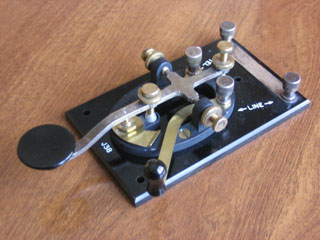
A telegraph key, clacker, tapper or morse key is a specialized electrical switch used by a trained operator to transmit text messages in Morse code in a telegraphy system. Keys are used in all forms of electrical telegraph systems, including landline telegraphy and radio telegraphy. An operator uses the telegraph key to send electrical pulses of two different lengths: short pulses, called dots or dits, and longer pulses, called dashes or dahs. These pulses encode the letters and other characters that spell out the message.
A continuous wave or continuous waveform (CW) is an electromagnetic wave of constant amplitude and frequency, typically a sine wave, that for mathematical analysis is considered to be of infinite duration. It may refer to e.g. a laser or particle accelerator having a continuous output, as opposed to a pulsed output.
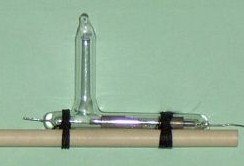
The coherer was a primitive form of radio signal detector used in the first radio receivers during the wireless telegraphy era at the beginning of the 20th century. Its use in radio was based on the 1890 findings of French physicist Édouard Branly and adapted by other physicists and inventors over the next ten years. The device consists of a tube or capsule containing two electrodes spaced a small distance apart with loose metal filings in the space between. When a radio frequency signal is applied to the device, the metal particles would cling together or "cohere", reducing the initial high resistance of the device, thereby allowing a much greater direct current to flow through it. In a receiver, the current would activate a bell, or a Morse paper tape recorder to make a record of the received signal. The metal filings in the coherer remained conductive after the signal (pulse) ended so that the coherer had to be "decohered" by tapping it with a clapper actuated by an electromagnet, each time a signal was received, thereby restoring the coherer to its original state. Coherers remained in widespread use until about 1907, when they were replaced by more sensitive electrolytic and crystal detectors.

In a radio receiver, a beat frequency oscillator or BFO is a dedicated oscillator used to create an audio frequency signal from Morse code radiotelegraphy (CW) transmissions to make them audible. The signal from the BFO is mixed with the received signal to create a heterodyne or beat frequency which is heard as a tone in the speaker. BFOs are also used to demodulate single-sideband (SSB) signals, making them intelligible, by essentially restoring the carrier that was suppressed at the transmitter. BFOs are sometimes included in communications receivers designed for short wave listeners; they are almost always found in communication receivers for amateur radio, which often receive CW and SSB signals.
A telegraph code is one of the character encodings used to transmit information by telegraphy. Morse code is the best-known such code. Telegraphy usually refers to the electrical telegraph, but telegraph systems using the optical telegraph were in use before that. A code consists of a number of code points, each corresponding to a letter of the alphabet, a numeral, or some other character. In codes intended for machines rather than humans, code points for control characters, such as carriage return, are required to control the operation of the mechanism. Each code point is made up of a number of elements arranged in a unique way for that character. There are usually two types of element, but more element types were employed in some codes not intended for machines. For instance, American Morse code had about five elements, rather than the two of International Morse Code.
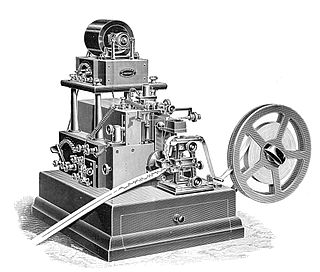
The syphon or siphon recorder is an obsolete electromechanical device used as a receiver for submarine telegraph cables invented by William Thomson, 1st Baron Kelvin in 1867. It automatically records an incoming telegraph message as a wiggling ink line on a roll of paper tape. Later a trained telegrapher would read the tape, translating the pulses representing the "dots" and "dashes" of the Morse code to characters of the text message.

American Morse Code — also known as Railroad Morse—is the latter-day name for the original version of the Morse Code developed in the mid-1840s, by Samuel Morse and Alfred Vail for their electric telegraph. The "American" qualifier was added because, after most of the rest of the world adopted "International Morse Code," the companies that continued to use the original Morse Code were mainly located in the United States. American Morse is now nearly extinct—it is most frequently seen in American railroad museums and American Civil War reenactments—and "Morse Code" today virtually always means the International Morse which supplanted American Morse.

Procedural signs or prosigns are shorthand signals used in Morse code telegraphy, for the purpose of simplifying and standardizing procedural protocols for landline and radio communication. The procedural signs are distinct from conventional Morse code abbreviations, which consist mainly of brevity codes that convey messages to other parties with greater speed and accuracy. However, some codes are used both as prosigns and as single letters or punctuation marks, and for those, the distinction between a prosign and abbreviation is ambiguous, even in context.
A radiogram is a formal written message transmitted by radio. Also known as a radio telegram or radio telegraphic message, radiograms use a standardized message format, form and radiotelephone and/or radiotelegraph transmission procedures. These procedures typically provide a means of transmitting the content of the messages without including the names of the various headers and message sections, so as to minimize the time needed to transmit messages over limited and/or congested radio channels. Various formats have been used historically by maritime radio services, military organizations, and Amateur Radio organizations.
A tikker, alternately spelled ticker, was a vibrating interrupter used in early wireless telegraphy radio receivers such as crystal radio receivers in order to receive continuous wave (CW) radiotelegraphy signals.
In CW Morse code operations, QSK or full break-in operation describes an operating mode in which the transmitting station can detect signals from other stations between the elements or letters of the Morse transmission. This allows other stations to interrupt the transmitting station between individual coding elements, and such allows for a conversational style of communication.
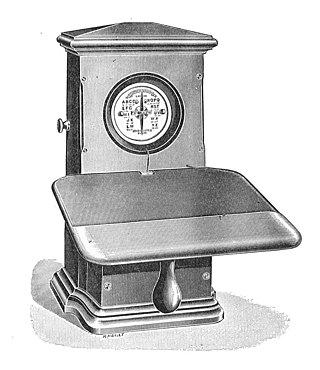
A needle telegraph is an electrical telegraph that uses indicating needles moved electromagnetically as its means of displaying messages. It is one of the two main types of electromagnetic telegraph, the other being the armature system, as exemplified by the telegraph of Samuel Morse in the United States. Needle telegraphs were widely used in Europe and the British Empire during the nineteenth century.

The Wheatstone system was an automated telegraph system that replaced a human operator with machines capable of sending and recording Morse code at a consistent fast rate. The system included a perforator, which prepared punched paper tape called a Wheatstone slip, a transmitter that read the tape and converted the symbols into dots and dashes encoded as mark and space electric currents on the telegraph line, and a receiver at the other end of the telegraph line that printed the Morse symbols. The system was invented by Charles Wheatstone. Enhancements could be made so that it was a duplex system, able to send and receive on the same line simultaneously.
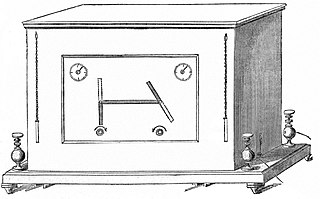
The Foy–Breguet telegraph, also called the French telegraph, was an electrical telegraph of the needle telegraph type developed by Louis-François-Clement Breguet and Alphonse Foy in the 1840s for use in France. The system used two-needle instruments that presented a display using the same code as that on the optical telegraph of Claude Chappe. The Chappe telegraph was extensively used in France by the government, so this arrangement was appealing to them as it meant there was no need to retrain operators.















